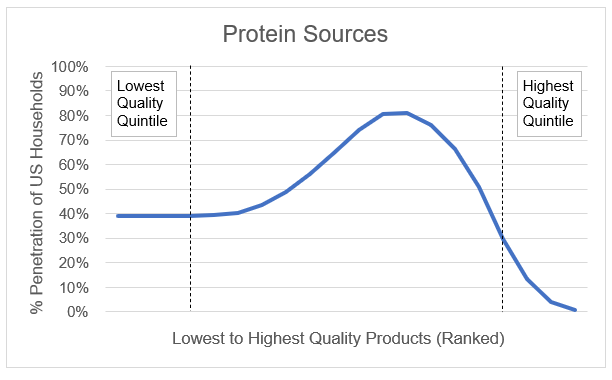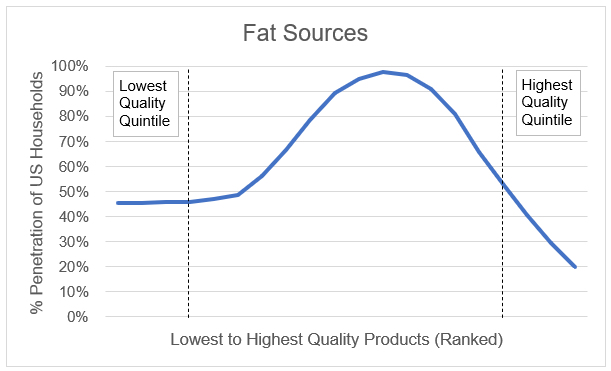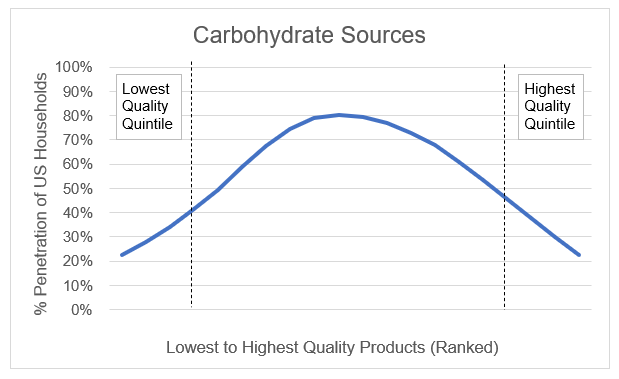Introducing Quality Distributions
Note: This is an addendum to previous posts What is Quality? (Part 1 and Part 2)
“The normal distribution is the bell under which all other distributions hide”
- Frank Anscombe
What is the likelihood I am consuming quality?
I would like to introduce an oversimplified framework for evaluating quality. First, stack rank all products in a category according to a hypothetical “quality score”. Then, for each “quality score” decile, determine what % of the US population is regularly consuming such products on average. Arguably, two individuals will have different views on ranked “quality scores” but let us assume the rankings across say all ~50,000 food and beverage products at Walmart or Kroger, informed by probabilities associated with scientific research, would be directionally accurate. For example, most consumers would rank organic broccoli much higher than Skittles.
I share below what I believe an *illustrative* curve looks like for 3 major categories of nutrition (aka macronutrients): primarily protein sources, primarily fat sources, and primarily carbohydrate sources (aka the 3 macronutrients).
My hypotheses, that I would love to see supported or challenged by actual data one day, are:
Protein sources, since they tend to magnify the underlying impact of nutrient inputs and because they are more complex compounds to produce relative to fats and carbohydrates1, have the widest gaps between the highest quality and lower quality products. This gap in quality leads to a wide gap in pricing (and perhaps taste?) for high versus low quality products, which limits consumer adoption for the highest quality decile (e.g. grass-fed and grass-finished beef is <1% of the US beef market today2). In simple terms, I believe the data would indicate that the vast majority of the US population does not believe that high quality protein is worth paying a premium for on a regular basis.
Fat sources also have a meaningful quality dispersion driven by pricing and taste – but not as extreme as protein sources. Trans fats are still used in highly processed foods and canola is the kitchen and restaurant staple for cooking oil. The recent popularity of paleo and keto diets (note: not suitable for everyone and extremely difficult to sustain), supported by legitimate research, has highlighted other fats (e.g. avocado, ghee, coconut, nuts) more likely to be healthier3.
Carbohydrate sources, the main product of plants, exhibit a more flat, symmetrical distribution. Given the widely broadcast diabetes and pre-diabetes epidemics, anecdotally it feels like we have made it past ‘peak sugar’ and ‘peak gluten’. Apart from bread, consumers appear to realize that highly fibrous carbs (e.g. cruciferous veggies4) affect blood glucose levels much less than non-fibrous carbs (e.g. potatoes, rice, chips / crackers). Organic fresh produce offerings have become abundant from Costco to Walmart.
At this point, I can hear most people say, but what about the quality of taste?! Doesn’t the deliciousness of food play a role here? Absolutely. Although I believe taste is even more subjective than nutritional quality – as such, for simplicity, I have left it out of the above framework. Of course food should taste amazing too. Nature has hard-wired deliciousness by endowing us with highly sensitive taste buds that exist for the sole purpose of nourishing our bodies (unless they are co-opted by highly engineered processed foods).
Another concern may be around the viability of paying a premium for perceived higher quality products. By selling direct to consumers, local farmers markets (offering fresh produce and meats) may offer prices only a few dollars per pound more than the grocery store. My go-to source for organic5 berries and greens, Costco has even caught on.
Channeling Daniel Kahneman’s Type 2 decision making approach, I believe a thoughtful balancing of the costs and benefits of eating quality food, informed by data, is the best approach to decision making. Since eating and drinking are some of the only activities we do everyday, from cradle to grave, my goal has been to highlight some interesting trade-offs that I have personally pondered. Choose wisely!
Proteins are the most complex of the three macronutrients and code for building / repairing tissues, fighting infection, transporting nutrients / hormones, among other functions. There are 20 different amino acids that can be combined in different ways to form a variety of different proteins. As such, proteins can be very large and complex molecules. In contrast, fats and carbohydrates are relatively simple molecules while still essential for the body. Fats are made up of fatty acids and glycerol, while carbohydrates are made up of simple sugars such as glucose and fructose.
See Food: WTF Should I Eat? (Hyman, 2018) “Fats and Oils” p145




